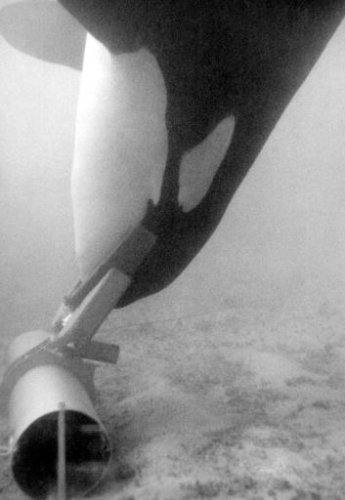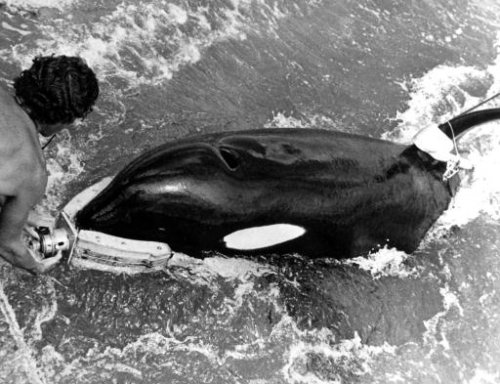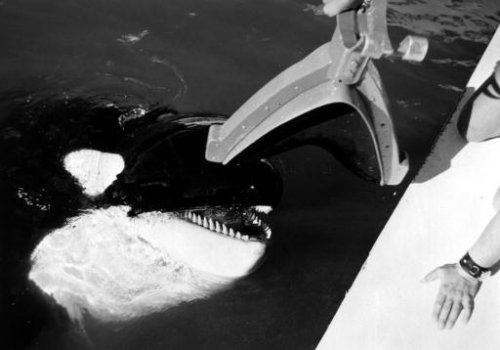- Joined
- 18 March 2008
- Messages
- 3,529
- Reaction score
- 978
An interesting way of achieving this capability:
http://oai.dtic.mil/oai/oai?verb=getRecord&metadataPrefix=html&identifier=AD0754396
Abstract : Two species of whales, killer whales (Orcinus orca) and pilot whales (Globicephala scammoni), were conditioned to locate and mark for recovery pingered cylindrical objects in the open ocean. The animals were conditioned to boat-follow, wear harnesses with radio backpacks, and deploy mouth-carried recovery hardware. An automatic direction-finding radio tracking system, originally developed for studies of wild marine mammals, was adopted and transformed to a system which is practical and reliable for day-to-day use with trained whales in the open ocean. The killer whales dived to maximum depths of 850 feet and 500 feet to deploy practice grabbers. The pilot whale deployed a practice grabber at a depth of 1654 feet and on one occasion apparently made a volunteered dive (without practice grabber) to a depth of 2000 feet. Float-line recovery devices proved ineffectual, leading to the development of a hydrazine lift system, which was fitted to the operational Grabber and is capable of lifting 600 pounds from 1000 feet. The pilot whale aided in the recovery of a dummy Mk 46 torpedo from 500 feet with this device, and during an earlier training session depolyed the hydrazine system on the same target at a 1000-foot depth.
http://oai.dtic.mil/oai/oai?verb=getRecord&metadataPrefix=html&identifier=AD0754396
Describes in detail the US Navy program from 1968 to 1971 for two male killer whales (Ahab and Ishmael) which were captured in Puget Sound, WA and airlifted to Point Mugu, CA, and later to Kaneohe, HI. Both killer whales were maintained at NUC Hawaii in fenced ocean pens, "...with low maintenance costs and excellent animal health." By September 1970, both whales had attained "open ocean reliability," wherein they would accompany a vessel out to sea an average of five times per week for a round trip distance of 10-12 nautical miles, typically swimming alongside the vessel at speeds of 6-7 knots. Ishmael on 19 February 1971 did not respond to his underwater recall signal and apparently swam away. On 8 June 1971, Ahab went on a 24 hour excursion ranging over 50 nautical miles in a northwesterly direction along the Oahu coast, and no further sea trials were conducted with him. Ahab died in 1974 at an estimated age of 15-16.
Abstract : Two species of whales, killer whales (Orcinus orca) and pilot whales (Globicephala scammoni), were conditioned to locate and mark for recovery pingered cylindrical objects in the open ocean. The animals were conditioned to boat-follow, wear harnesses with radio backpacks, and deploy mouth-carried recovery hardware. An automatic direction-finding radio tracking system, originally developed for studies of wild marine mammals, was adopted and transformed to a system which is practical and reliable for day-to-day use with trained whales in the open ocean. The killer whales dived to maximum depths of 850 feet and 500 feet to deploy practice grabbers. The pilot whale deployed a practice grabber at a depth of 1654 feet and on one occasion apparently made a volunteered dive (without practice grabber) to a depth of 2000 feet. Float-line recovery devices proved ineffectual, leading to the development of a hydrazine lift system, which was fitted to the operational Grabber and is capable of lifting 600 pounds from 1000 feet. The pilot whale aided in the recovery of a dummy Mk 46 torpedo from 500 feet with this device, and during an earlier training session depolyed the hydrazine system on the same target at a 1000-foot depth.



